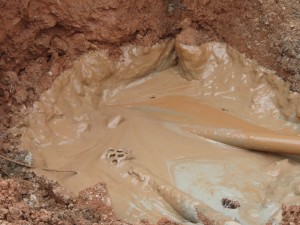The Straight Skinny on Bentonite-Based Drilling Muds and Their Standard Practice Use in the Horizontal Well Industry
Let’s make our point up front:
1) Bentonite-based drilling fluid is NOT bad for horizontal well projects.
2) It does not damage the formation.
3) It is a naturally occurring clay material that is mined.
4) It does flush easily/adequately during horizontal well development

Most remediation professionals have designed and/or installed vertical wells at one time or another during their careers. After advancing the boring, setting the screen/riser and sand pack, the vertical driller usually pours dry bentonite chips or pellets into the annular space between the vertical well and formation. The vertical driller then adds water to hydrate the bentonite, creating a very effective seal as the bentonite swells (or “yields”).
Why are we discussing a topic that is common knowledge/practice to most remediation professionals?
Because some people who claim to be experts at installing horizontal wells assert that bentonite-based drilling fluids damage the formation and cannot be adequately flushed from the annular space during development. These are false assertions that distort what actually happens when bentonite-based drilling fluid is used.
These false assertions feed off of most remediation professional’s real-world experience when dry bentonite is intentionally hydrated in situ to create a seal in a vertical monitoring well. In other words, an attempt is being made to make you think that because straight bentonite hydrated in situ makes a great seal, it does the same thing when used in a drilling fluid when installing a horizontal well.
The argument turns on the fact that:
- bentonite-based drilling fluid is hydrated ex situ and yields prior to commencing directional drilling; and
- bentonite is a component of the directional drilling mud system, not the sole component.
A “seal” is never formed by bentonite in a horizontal well and in addition Directional Technologies, Inc. uses a proprietary process to develop the horizontal wells based on years of field experience in the oil field, the utility industry and the environmental industry. This development process results in fully functional horizontal wells.
The same horizontal remediation well professionals criticize bentonite-based drilling mud also advocate the use of “bio-polymer” drilling muds. These are manmade products based on gaur gums and vegetable products that biodegrade after use to various types of sugars that purportedly “jump start” the bioremediation process by supplying nutrients to naturally occurring bacteria. The problem with this is that the sugars tend to enhance undesirable bacteria that can create slime that damages the formation.
Directional Technologies develops and formulates specific drilling fluid programs for each horizontal remediation well we install.
We do not use a one-dimensional, “one-size-fits-all” drilling program. There is both a science and an art to creating the optimal drilling fluid program for each horizontal well installation. It is imperative that the selected directional drilling fluid(s) build the bore path to:
- prevent formation damage;
- enable safe, cost-efficient directional drilling/horizontal well installation; and
- prevent bio-fouling.
Stay tuned for additional technical communications regarding the horizontal well installation process or contact us.